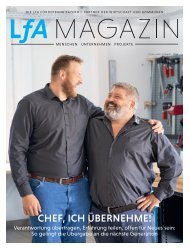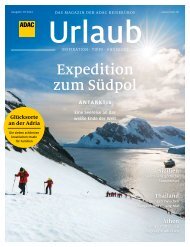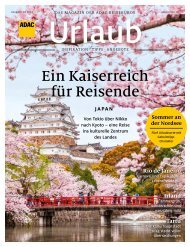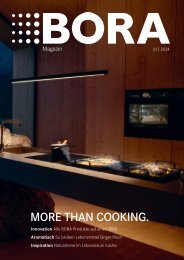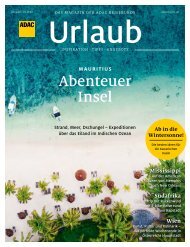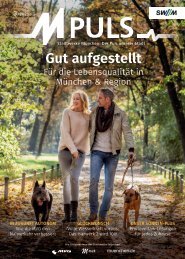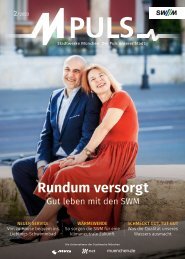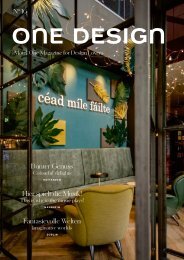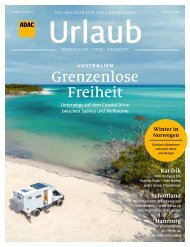ONELIFE #36 – English
Land Rover’s Onelife magazine showcases stories from around the world that celebrate inner strength and the drive to go Above and Beyond. This special issue of Onelife marks Land Rover’s 70th anniversary – a celebration of unparalleled achievement and pioneering innovation. We bring you the incredible story of how we reunited an original 1948 car with its former owners, as well as looking back at Land Rover vehicles’ most intrepid expeditions around the globe.
Land Rover’s Onelife magazine showcases stories from around the world that celebrate inner strength and the drive to go Above and Beyond.
This special issue of Onelife marks Land Rover’s 70th anniversary – a celebration of unparalleled achievement and pioneering innovation. We bring you the incredible story of how we reunited an original 1948 car with its former owners, as well as looking back at Land Rover vehicles’ most intrepid expeditions around the globe.
Create successful ePaper yourself
Turn your PDF publications into a flip-book with our unique Google optimized e-Paper software.
PRE-PRODUCTION CAR NO. 7<br />
Below left: Tim Hannig,<br />
Director of Jaguar Land<br />
Rover Classic (left) with<br />
Mike Bishop, the Land<br />
Rover historian and Classic<br />
Collection Curator who<br />
authenticated L07.<br />
Below right: The patina of<br />
the car will be retained<br />
“ALL THE SUCCESS<br />
THAT WAS TO COME<br />
FOR LAND ROVER<br />
ESSENTIALLY CAME<br />
OFF THE BACK<br />
OF THIS VERY CAR”<br />
TIM HANNIG, DIRECTOR,<br />
JAGUAR LAND ROVER CLASSIC<br />
HARD LABOUR<br />
Its disappearance from records led Land Rover experts to assume<br />
SNX 910 had been scrapped, while Reg Mason discovered from<br />
the man he bought the ‘rotbox’ from that it had possibly been used<br />
on a dairy farm for most of the following decade before coming to<br />
rest in a field in Wales, where it spent another 20 years hard labour<br />
being used as a static power source to drive a wood saw.<br />
Whatever it was used for, a cursory look at the heavily marked,<br />
battle-worn and multi-coloured bodywork of number 7 suggests<br />
that it didn’t lead an easy life. Even June Maddison, Alexander<br />
Maddison’s widow (who Onelife tracked down especially for this<br />
piece), had no knowledge of her husband’s Series 1 beyond 1969.<br />
It was an emotional reunion for her with the car, as she immediately<br />
recognised her late husband’s handwriting on the log book from<br />
entries in 1967 and 1968. “Alexander owned a lot of motorcycles<br />
and cars around that time,” she says, “and this is one of several<br />
Land Rovers he had.” He would most likely have had no knowledge<br />
of how significant this one was while in his ownership.<br />
PRESERVING AN ICON<br />
Today, however, number 7’s huge significance means that it will<br />
be brought back to life by Classic Works, Jaguar Land Rover’s<br />
dedicated restoration and parts facility near Coventry.<br />
“The plan is to undertake a ‘patina restore’ on the car, with a full<br />
mechanical overhaul,” explains experienced engineer Susan Tonks,<br />
the project manager for the car. “L07 will be brought up to current<br />
MoT standards so will be perfectly safe to drive, but it will still look<br />
like a 70-year-old car, just like it does now.”<br />
Luckily for Tonks, most of the car’s body panels and bonnet are<br />
salvageable, and even the original windscreen and surround has<br />
somehow survived intact. She can thank the Series 1 prototype’s<br />
galvanized chassis and extra thick Birmabright aluminium alloy<br />
construction for that. Some other areas of the car, however, will need<br />
more work. “The bulkhead is quite badly rusted. That’s the bit<br />
24





